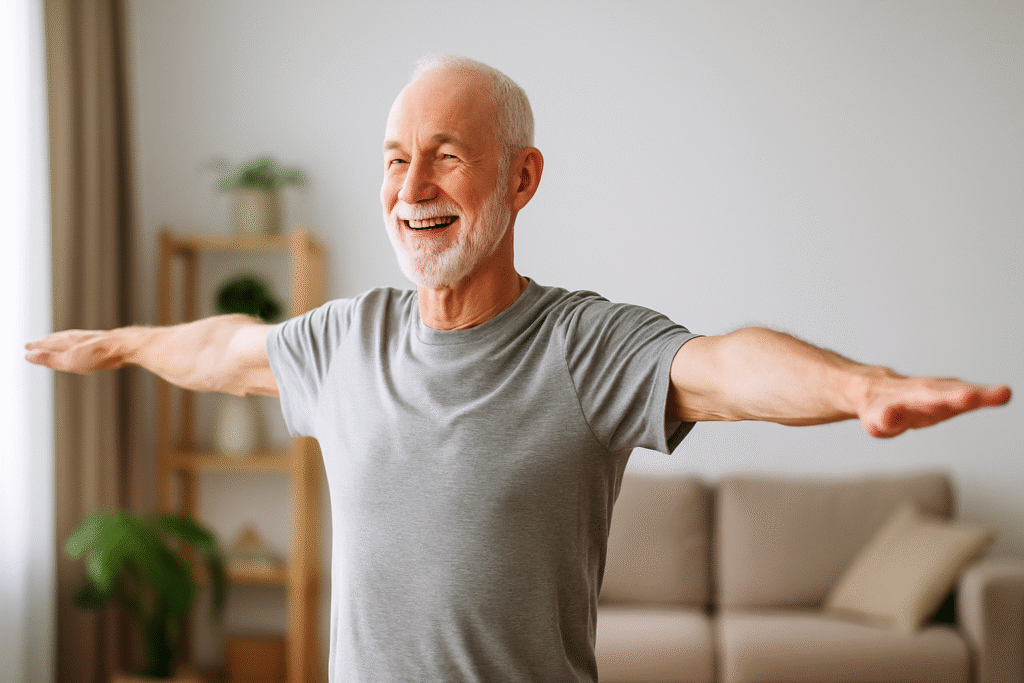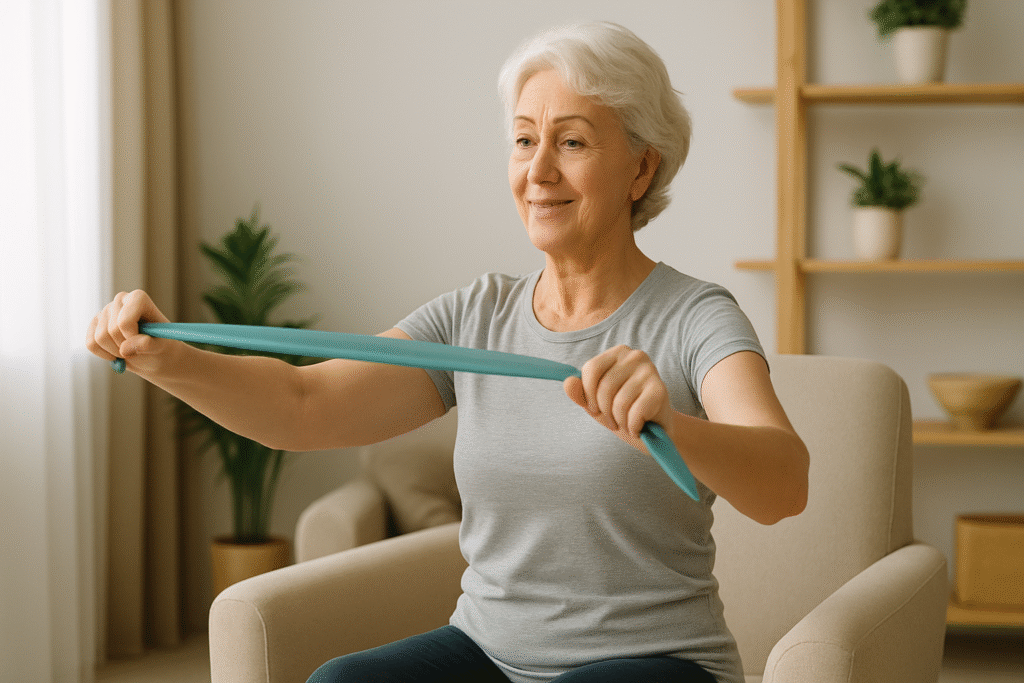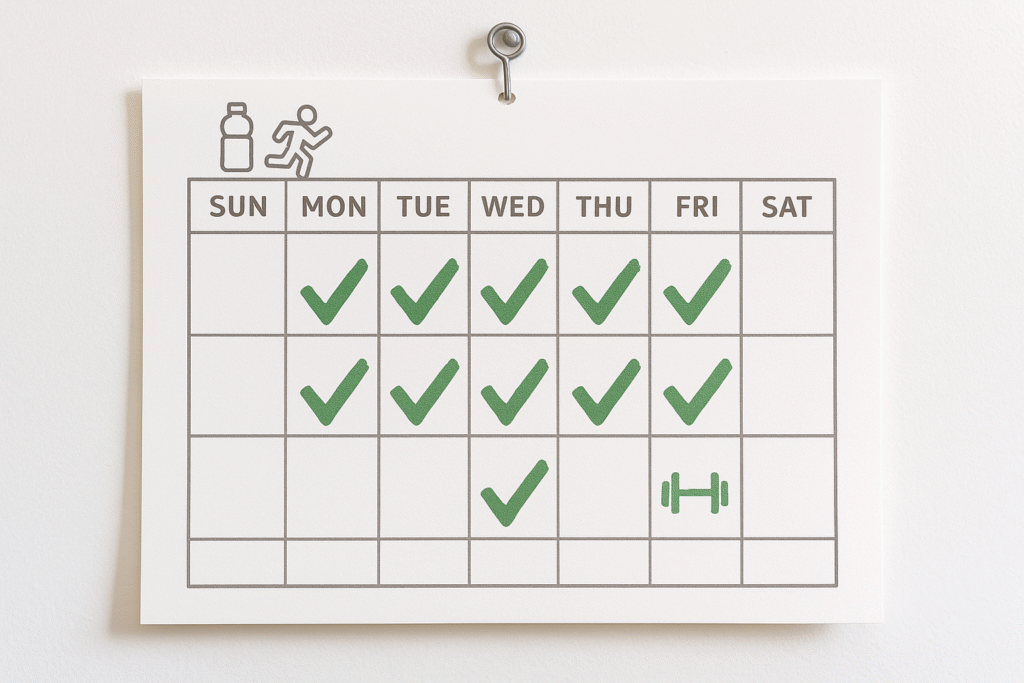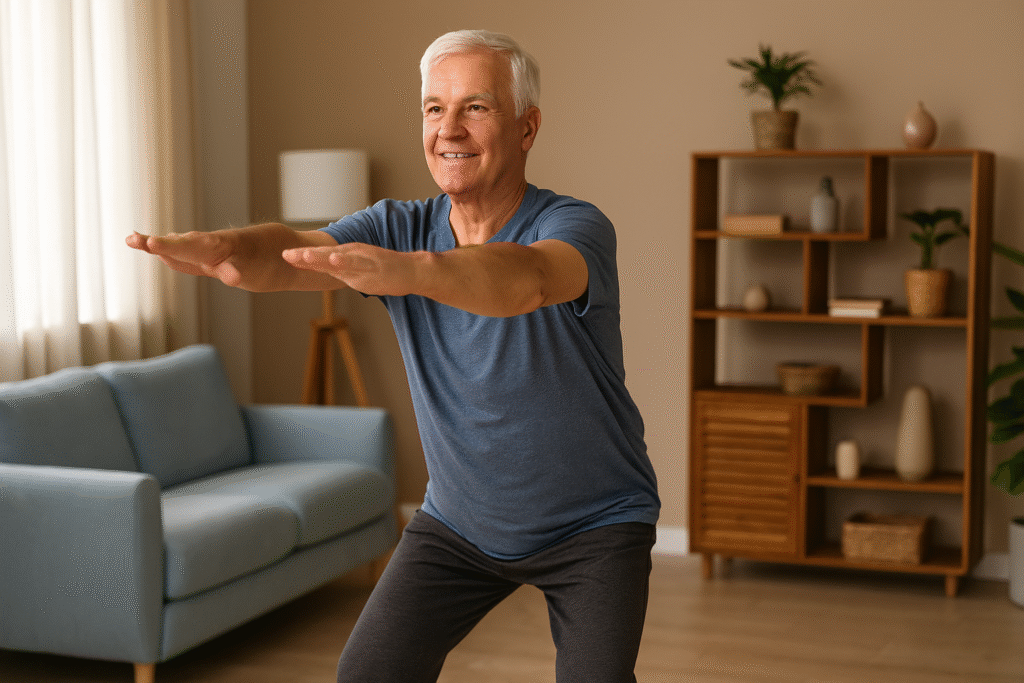As we age, staying active becomes more important than ever—but also more challenging. For adults over 60, joint pain, reduced flexibility, and lower energy levels can make traditional workouts feel overwhelming or even unsafe. Yet, research shows that just 25 minutes of full-body movement per day can significantly improve mobility, strength, balance, and even mood.
In this guide, we’ll walk you through the best 25-minute senior workout routine designed specifically for people over 60. It’s low-impact, easy to follow, and targets all the essential muscle groups to help you maintain independence and vitality. Whether you’re just getting started or looking to optimize your daily movement, this full-body routine will meet you where you are — and move you forward.
Ready to feel stronger and more confident in just 25 minutes a day? Let’s begin.
Why Exercise Matters After 60: The Science of Staying Strong
For adults over 60, consistent physical activity isn’t just about maintaining a beach body — it’s a lifesaving necessity. As we age, we experience sarcopenia (age-related muscle loss), bone density reduction, balance decline, and slower metabolism. But here’s the good news: regular, full-body workouts can counteract all of this — and more.
Muscle Loss and Aging — The Hidden Threat
After age 30, adults lose up to 5% of muscle mass per decade — a condition known as sarcopenia. For seniors, this translates into difficulty climbing stairs, standing up from chairs, or carrying groceries.
The fix? Resistance-based exercises. Movements like squats, push-ups (wall-modified), and resistance band pulls stimulate muscle fiber activation even at low intensities — crucial for preventing frailty.
Bone Density, Balance, and Fall Prevention
Falls are the leading cause of injury-related deaths among older adults. Low-impact weight-bearing movements like bodyweight squats and heel raises stimulate bone remodeling, making bones stronger and more fracture-resistant.
Balance-focused exercises — think standing leg lifts or tandem walking — retrain your proprioception system, reducing your risk of falls by up to 30%, according to NIH studies.
💓Heart Health and Blood Sugar Control
Even moderate full-body workouts increase your heart rate, improving circulation and reducing cardiovascular risk. For individuals with prediabetes or insulin resistance, full-body movement improves glucose uptake by muscle cells, enhancing insulin sensitivity without medication.
📌 Did You Know?
Just 25 minutes of daily exercise can reduce all-cause mortality by up to 35% in adults over 60, according to a major 2023 meta-analysis published in the British Journal of Sports Medicine.
Mental Clarity, Mood, and Cognitive Function
Exercise also protects your mental faculties. A full-body routine enhances brain-derived neurotrophic factor (BDNF), a protein essential for memory retention and learning. Additionally, physical movement reduces cortisol and increases serotonin, easing symptoms of depression and anxiety.
✅ Expert Summary
Regular full-body workouts in older age promote:
- Muscle strength and joint stability
- Better balance and reduced fall risk
- Improved heart and metabolic health
- Sharper cognitive function
- Elevated mood and reduced anxiety
By understanding the science behind exercise benefits, you can appreciate why this 25-minute senior workout isn’t just helpful — it’s essential.
How to Build the Perfect 25-Minute Full-Body Workout for Seniors Over 60
Designing an effective workout for adults over 60 requires a balance between safety and stimulation. Each movement should engage major muscle groups without placing stress on the joints — all while promoting balance, coordination, and cardiovascular activity.

Here’s how to structure a time-efficient, safe, and results-driven 25-minute routine that you can do at home — no fancy equipment needed.
The Ideal Time Split — Warm-Up, Core Workout, Cooldown
The most efficient senior-friendly workout divides the 25 minutes as follows:
- Warm-Up (5 minutes): Joint mobility and light cardio
- Main Circuit (15 minutes): 6 full-body exercises, repeated in two rounds
- Cooldown + Stretch (5 minutes): Flexibility and breathing exercises
Each section serves a physiological purpose — warming up synovial fluid in joints, boosting heart rate, and then guiding the body back to homeostasis.
Warm-Up (5 Minutes) — Preparing Your Body Safely
Warming up isn’t optional. A proper warm-up increases blood flow, lubricates joints, and activates neuromuscular connections.
Here’s a sample senior-friendly warm-up:
- March in place – 1 minute
- Shoulder rolls forward/back – 30 seconds each
- Arm circles (small to big) – 1 minute
- Hip circles and side bends – 1 minute
- Heel-to-toe rock + ankle rolls – 1 minute
💡 Quick Tip: If mornings are tough on your joints, warm up later in the day when your body is less stiff.
The 15-Minute Full-Body Circuit
This is the core of your routine. You’ll perform 6 simple exercises, each for 45 seconds with a 15-second rest. Repeat the circuit twice.
Round 1 & 2 Exercises:
- Chair Squats – Strengthens glutes, thighs, and core
- Wall Push-Ups – Upper body strength without strain
- Seated Knee Lifts – Core and hip mobility
- Standing Side Leg Raises – Balance and outer hip muscles
- Resistance Band Rows – Posture and back muscles
- March in Place with Arm Swings – Cardio finisher
If you’re looking for a guided version of this routine, the video below walks you through a full 25-minute senior workout — step by step. It’s ideal for beginners and follows the same safe, full-body structure we’ve just explored.
Follow along with the video at your own pace, and feel free to pause or modify any movement as needed — your safety and comfort come first.
Cooldown and Stretch (5 Minutes)
Finish strong with slow, deliberate movements that reduce heart rate and prevent stiffness:
- Seated hamstring stretch – 1 minute
- Overhead side stretch – 1 minute
- Neck rolls and shoulder shrugs – 1 minute
- Seated breathing with arms up/down – 2 minutes
These cooldown movements promote lymphatic drainage and relaxation, improving sleep and recovery.
✅ Expert Summary
This structure ensures:
- Muscle engagement without joint overload
- Heart-healthy cardio built into functional movement
- Balanced development of strength, flexibility, and coordination
No gym? No problem. With a chair, resistance band, and a bit of space, your living room becomes a full-body training zone.
Adapting the Routine: Safe Modifications for Common Senior Limitations
Not every senior over 60 starts from the same baseline. Some may be relatively fit, while others struggle with arthritis, joint pain, past injuries, or limited balance. A workout plan is only effective if it’s sustainable and adaptable.

This section helps you tailor each phase of the 25-minute routine to fit real-world challenges — while maintaining results.
Joint Pain and Arthritis — Low-Impact Alternatives
For seniors with osteoarthritis, especially in the knees or hips, joint pressure must be minimized without skipping strength-building:
- Replace Chair Squats with Sit-to-Stands Using Cushioned Surfaces
If squats cause pain, use a pillow on a firm chair for extra support and reduce range of motion.
➤ Tip: Keep knees aligned with toes to protect the joints. - Avoid Deep Lunges
Instead, perform wall-supported mini-squats or step-ups onto a low platform (4–6 inches). - Use Resistance Bands, Not Dumbbells
Bands create progressive tension without compressive joint force.
📌 Did You Know?
Resistance bands reduce joint loading by up to 40% compared to free weights, making them ideal for arthritic joints.
Balance Issues — Training While Seated or Supported
If balance is compromised, standing routines may cause anxiety or even lead to falls. But movement can still be productive and safe:
- Seated Leg Extensions and Knee Lifts
These activate the quads and core with no risk of falling. - Use a Chair or Wall for Support
All standing movements — such as side leg lifts — can be done with one hand on a stable object. - Perform “Toe-Stand Marches” Holding a Counter
Rise on your toes and slowly march in place, holding for 3 seconds each step — a powerful way to stimulate ankle proprioceptors.
Breathing Difficulties or Cardiopulmonary Conditions
Shortness of breath from conditions like COPD or heart disease shouldn’t mean abandoning exercise. Adjust tempo, position, and intensity:
- Slower Tempo with Extended Rest Intervals
Instead of 45 seconds per exercise, try 30 seconds with 30 seconds rest. - Avoid Forward Bends
These can restrict breathing — prefer upright motions like shoulder rolls, arm lifts, or gentle torso rotations. - Use Diaphragmatic Breathing During Cooldowns
Helps oxygenate tissues more efficiently and reduce post-exercise fatigue.
💡 Quick Tip:
Monitor perceived exertion using a 1-to-10 scale. Aim to keep intensity at 4–6, where you’re challenged but still able to speak.
✅ Expert Summary
Smart modifications mean no one is left behind:
- Pain doesn’t mean pause — it means adapt
- Balance can improve with seated or supported training
- Breathing issues can be accommodated through pacing and posture
A safe workout is not a compromise — it’s a strategy.
Mental & Emotional Benefits of Full-Body Workouts After 60
Exercise isn’t just a tool for physical health — it’s a proven, science-backed strategy for mental resilience, emotional balance, and cognitive sharpness, especially in older adults. In fact, for many over 60, the most profound changes from a consistent workout routine are felt in the mind, not just the muscles.

Reducing Anxiety, Depression, and Loneliness
Seniors often face emotional challenges like isolation, loss of purpose post-retirement, or grief — all of which can manifest as depression or anxiety. Studies show that just 20–30 minutes of moderate exercise can:
- Lower cortisol levels (the stress hormone)
- Increase serotonin and dopamine, the feel-good neurotransmitters
- Promote endorphin release, which naturally boosts mood
According to the American Psychological Association, exercise is as effective as antidepressants in treating mild-to-moderate depression in older adults — without side effects.
💡 Quick Tip: Add soft music or nature sounds during your routine to elevate emotional benefits. Auditory stimulation combined with movement deepens the mind-body connection.
Boosting Memory, Focus, and Brain Health
Age-related cognitive decline doesn’t have to be inevitable. Regular movement improves neuroplasticity — the brain’s ability to form new connections — and boosts blood flow to key regions like the hippocampus, which controls memory.
Clinical trials published in Neurology and JAMA show that adults over 60 who exercised consistently for 6+ months showed:
- Better verbal memory
- Improved reaction times
- Enhanced executive function (planning, focus, decision-making)
✅ Expert Summary
Here’s how full-body movement impacts brain health:
- Increased BDNF (brain-derived neurotrophic factor) → supports learning and memory
- More oxygen and glucose to the brain → fuels mental clarity
- Better sleep patterns → crucial for memory consolidation
Enhancing Emotional Regulation and Confidence
It’s not just about avoiding mental decline — it’s about thriving emotionally. Consistent physical activity helps seniors:
- Regulate emotions more easily under stress
- Build confidence by mastering new physical tasks
- Feel empowered and independent, even with physical limitations
📌 Did You Know?
A recent NIH-funded study found that older adults who exercised three times per week had 40% lower rates of cognitive decline compared to sedentary peers — even if the workouts were short and low-impact.
Consistency Over Intensity: How to Make Exercise a Lifelong Habit After 60
Even the best-designed senior workout means little if it’s not practiced regularly. While intensity gets the spotlight in youth fitness, for adults over 60, consistency is king. Creating a sustainable, rewarding exercise habit is the ultimate secret to long-term strength, mobility, and independence.

Start with Frequency, Not Perfection
Many seniors abandon routines because they expect too much, too soon. The goal is not to train hard — it’s to show up regularly, even if the session is light or brief.
Best approach:
- Begin with 3 times per week, 25 minutes per session
- Focus on movement quality, not speed or reps
- Gradually increase frequency to 4–5 times weekly, alternating intensities
✅ Expert Summary
According to the CDC, adults over 65 should aim for at least 150 minutes per week of moderate activity — which can be broken into 25-minute sessions, six days a week.
Build a Routine Anchored to Existing Habits
Link your workout to something you already do. Behavioral science calls this habit stacking — and it dramatically improves adherence.
Examples:
- “After my morning tea, I’ll do my warm-up and 25-minute circuit.”
- “Before my evening news, I’ll stretch for 10 minutes.”
- “Every Tuesday, Thursday, and Saturday after breakfast — it’s movement time.”
📌 Did You Know?
People over 60 are 35% more likely to stick with a workout routine when it’s tied to a fixed time of day and location.
Vary the Stimulus to Avoid Boredom
Doing the exact same routine every day can become mentally and physically stale. Keep engagement high by introducing variation without changing your structure:
- Switch up exercises weekly within the same categories (e.g., wall push-ups → counter push-ups)
- Use music playlists to boost mood and rhythm
- Workout with a friend once a week for social accountability
💡 Quick Tip: Print a simple checklist and mark each completed session. Visual tracking increases motivation by 42% according to the Journal of Health Psychology.
Set Realistic, Functional Goals
Instead of “lose weight” or “tone up,” aim for function-oriented goals that directly impact daily life:
- Climb stairs without stopping
- Stand from a chair without using hands
- Carry groceries without fatigue
- Improve posture or balance confidence
These goals are measurable, motivating, and directly tied to independence and dignity — key values as we age.
What the Research Says: Evidence Behind Senior Fitness and Longevity
Scientific consensus around physical activity in later life is strong — and growing. Consistent, moderate-intensity workouts like the 25-minute full-body routine outlined here aren’t just beneficial — they’re critical for longevity, cognitive preservation, and quality of life.
Exercise Reduces All-Cause Mortality
A pivotal 2023 meta-analysis published in the British Journal of Sports Medicine found that as little as 75 minutes per week of moderate activity in seniors reduced all-cause mortality by over 35%, particularly in individuals over 65.
Another NIH-funded study corroborates that physical activity lowers the risk of chronic illnesses including cardiovascular disease, type 2 diabetes, and some cancers — regardless of when the activity begins in life.
🔗 Source: National Institutes of Health – Physical Activity and Mortality
Movement Enhances Cognitive Function and Brain Health
A 6-month randomized controlled trial published in Neurology showed that seniors who walked or did resistance training three times per week experienced significant increases in executive function, memory recall, and processing speed.
BDNF (brain-derived neurotrophic factor), which supports neuroplasticity and protects against Alzheimer’s, increases significantly after 20+ minutes of moderate activity, especially in full-body routines.
🔗 PubMed: Physical Activity and Cognition in Older Adults
Resistance Training Reduces Fall Risk and Improves Function
According to the CDC, fall prevention programs that include lower-body resistance movements and balance training reduce fall rates by up to 30%. This includes exercises like chair squats, side leg raises, and ankle flexions — all core parts of the recommended routine.
🔗 CDC – Important Facts About Falls
💡 Quick Tip: Strength training with resistance bands or bodyweight twice a week is endorsed by both the World Health Organization and the American College of Sports Medicine for adults over 60.
Conclusion: Stronger, Safer, and More Independent in Just 25 Minutes a Day
You don’t need to be an athlete — or spend hours at the gym — to transform your health after 60. This 25-minute full-body workout was designed with your safety, strength, and independence in mind. Just a few sessions per week can lead to real, lasting improvements in mobility, confidence, energy, and mental clarity.
The key isn’t perfection — it’s consistency. Every rep, every breath, and every moment of movement helps you age with power, not passivity.
📌 Main Takeaways
- Just 25 minutes a day can significantly improve strength, balance, and longevity for seniors.
- The routine is low-impact, equipment-light, and fully adaptable to limitations.
- Scientific studies confirm benefits for heart health, cognitive function, and emotional well-being.
- Consistency, realistic goals, and habit stacking are essential to long-term success.
- Visual guides like YouTube videos enhance safety and motivation.
🔗 Further Reading
Looking to expand your fitness and health journey? Check out these highly relevant articles:
- Unlock the Anti-Aging Secrets of Japanese Walking:
Japanese Walking: Fitness & Longevity Benefits - Curious About Yoga or Pilates? Discover Which One Fits Your Body Best:
Yoga vs. Pilates: Which Is Better for You? - Concerned About Prostate Health? This Review Could Save You Time and Money:
ProstaVive Review: Does It Really Work?
💥 Ready to take control of your health after 60?
Your body is capable of more than you think — and it starts with one 25-minute commitment today. Bookmark this routine, press play on the video, and move toward a stronger, more independent version of yourself. The best is yet to come.
What is the best full-body workout for seniors over 60?
The best routine includes low-impact exercises like chair squats, wall push-ups, leg lifts, and resistance band rows. These target major muscle groups while protecting joints and boosting strength, balance, and mobility — all in just 25 minutes.
How often should someone over 60 work out?
Aim for at least 3 sessions a week to start, then progress to 5–6 days if tolerated. The CDC recommends 150 minutes of moderate exercise weekly, which can be split into manageable 25-minute routines.
Can seniors really build muscle with short workouts?
Yes! Muscle growth after 60 is possible with consistent, moderate resistance training. Bodyweight and resistance band exercises are ideal for stimulating muscle fibers safely and effectively, even with short sessions.
Is it safe to work out with arthritis or joint pain?
Absolutely — when modified properly. Use chairs, walls, or bands for support, and avoid high-impact movements. Always listen to your body and focus on form over speed or reps.













